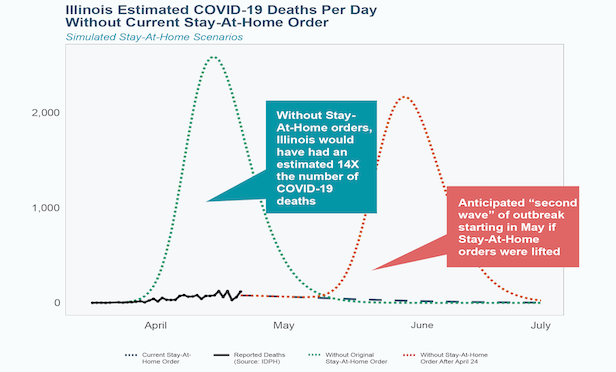 Without the stay at home order, the model estimates there would have been 10 to 20 times as many deaths to date in the State of Illinois.
Without the stay at home order, the model estimates there would have been 10 to 20 times as many deaths to date in the State of Illinois.
CHICAGO—Illinois Gov. JB Pritzker on Thursday issued a modified stay at home order that continues some restrictions, but also relaxes some measures imposed on residents and non-essential businesses in response to the onset of the Coronavirus pandemic.
The new stay at home order, which goes into effect on May 1 and will last through the month of May, requires face coverings in public.
"Make no mistake, Illinois has saved lives. By staying home and social distancing, we have kept our infection and death rates for the months of March and April thousands below the rates projected had we not implemented these mitigation strategies," said Gov. Pritzker. "I know how badly we all want our normal lives back. But this is the part where we have to dig in and understand that the sacrifices we've made as a state to avoid a worst-case scenario are working—and we need to keep going a little while longer to finish the job."
Highlights of the new order's modifications include:
• New Essential Businesses: Greenhouses, garden centers and nurseries may re-open as essential businesses. These stores must follow social distancing requirements and must require that employees and customers wear a face covering. Animal grooming services may also re-open.
• Non-Essential Retail: Retail stores designated as non-essential businesses and operations may re-open to fulfill telephone and online orders through pick-up outside the store and delivery.
• Essential Businesses and Manufacturing: Essential businesses and manufacturers will be required to provide face-coverings to all employees who are not able to maintain six-feet of social distancing, as well as follow new requirements that maximize social distancing and prioritize the well-being of employees and customers. This will include occupancy limits for essential businesses and precautions such as staggering shifts and operating only essential lines for manufacturers.
• Face Coverings: Beginning on May 1, individuals will be required to wear a face-covering or a mask when in a public place where they can't maintain a six-foot social distance. Face-coverings will be required in public indoor spaces, such as stores. This new requirement applies to all individuals over the age of two who are able to medically tolerate a face-covering or a mask.
• Schools: Educational institutions may allow and establish procedures for pick-up of necessary supplies or student belongings. Dormitory move-outs must follow public health guidelines, including social distancing.
• Outdoor Recreation: State parks will begin a phased re-opening under guidance from the Department of Natural Resources. Fishing and boating in groups of no more than two people will be permitted. A list of parks that will be open on May 1 and additional guidelines can be found on the Illinois Department of Natural Resources website Golf will be permitted under strict safety guidelines provided by the Illinois Department of Commerce and Economic Opportunity (DCEO) and when ensuring that social distancing is followed.
The state also released some alarming statistics regarding the devastation that would have occurred if restrictions were not put in place in response to the spread of COVID-19.
The modeling released on Thursday analyzed two months' worth of daily data on COVID-19 deaths and ICU usage in Illinois. Researchers from the University of Illinois at Urbana-Champaign, the Northwestern School of Medicine, the University of Chicago, the Chicago and Illinois Departments of Public Health, along with McKinsey and Mier Consulting Group working on behalf of the City of Chicago and Cook County, worked on these projections as a cohort under Civis Analytics, a data analytics firm with experience spanning the public and private sectors.
Without the stay at home order, the model estimates there would have been 10 to 20 times as many deaths to date and that the peak death rate and peak resource usage would have been 20 to 30 times what we will see with mitigation. Moreover, these counts do not account for deaths due to lack of access to health resources, so the actual number would likely have been even higher, state officials noted.
If the stay at home order were lifted this week, death rates and hospitalizations would start rising sharply by the middle of May. It's projected that the peak death rate and peak resource needs would be almost as high as if there were never any mitigation measures put in place. Over the course of the current outbreak, the model estimates there would be five to 10 times more deaths than we would see if we continued mitigation.
Since the onset of COVID-19, the Illinois Department of Health reported a total of 36,934 cases, including 1,688 deaths, in 96 counties in Illinois. The daily figures released yesterday by IDH included 1,826 new cases of COVID-19 in Illinois, including 123 additional deaths.
© Touchpoint Markets, All Rights Reserved. Request academic re-use from www.copyright.com. All other uses, submit a request to [email protected]. For more inforrmation visit Asset & Logo Licensing.







